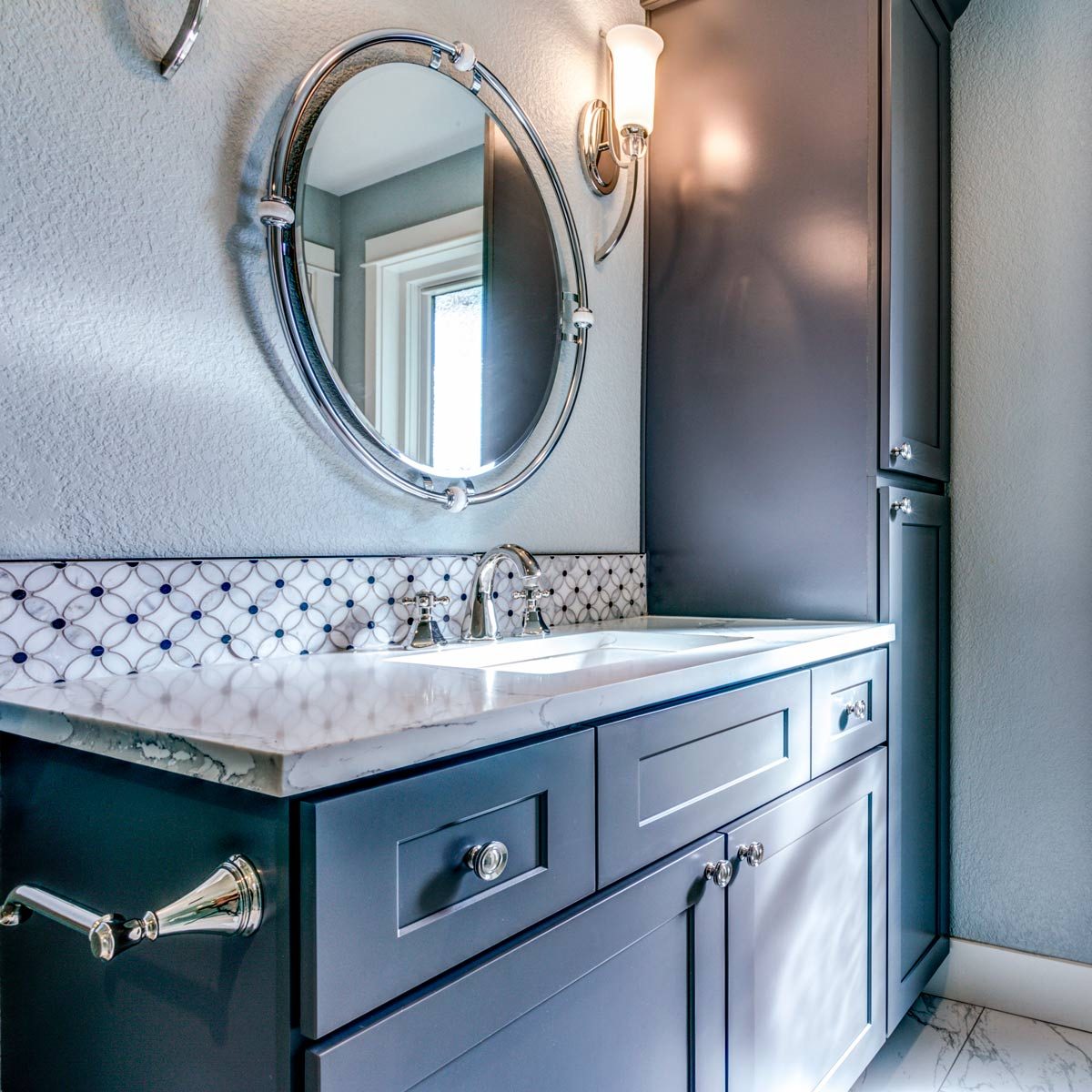Design Considerations for Backsplash behind Bathroom Sink

Backsplash behind bathroom sink – When designing the backsplash behind the bathroom sink, it’s crucial to consider the specific needs of a humid bathroom environment. The material should be resistant to moisture and easy to clean. Tile, stone, and glass are popular choices for their durability and aesthetic appeal.
The backsplash behind your bathroom sink can also play a role in any unpleasant smells coming from underneath it. Moisture and grime can build up on the backsplash, creating a breeding ground for bacteria and mold. This can lead to a musty or mildew smell that can permeate the entire bathroom.
To prevent this, regularly clean the backsplash with a disinfectant cleaner. You may also want to consider installing a backsplash that is resistant to moisture and mold to help keep your bathroom smelling fresh.
Color Schemes and Patterns
The color scheme and pattern of the backsplash should complement the overall bathroom décor. Neutral colors like white, beige, or gray provide a classic and timeless look, while bolder colors can add a touch of personality. Patterns like subway tile, mosaic tiles, or accent strips can create visual interest and add a unique touch.
Decorative Elements
Incorporating decorative elements into the backsplash can elevate the design and create a focal point. Mosaic tiles, accent strips, or even a shelf can add depth and dimension. These elements can be used to create a custom look that reflects personal style and preferences.
Your bathroom’s backsplash is a great way to add a touch of style to your space, and it can also help to protect your walls from water damage. If you’re looking for a new backsplash, consider installing one behind your bathroom vessel sink.
Vessel sinks are becoming increasingly popular, and they can add a touch of elegance to your bathroom. When choosing a backsplash for your vessel sink, you’ll want to consider the style of your bathroom and the type of material you want to use.
Bathroom vessel sink faucets come in a variety of styles, so you’re sure to find one that matches your taste. And, because they’re made from durable materials, they’ll last for years to come. With a little planning, you can create a beautiful and functional backsplash that will complement your bathroom vessel sink perfectly.
Functional Aspects of Backsplash behind Bathroom Sink

Backsplashes in bathrooms serve a crucial functional role in protecting the walls from water damage. The primary purpose of a backsplash is to create a water-resistant barrier between the sink and the wall, preventing moisture from seeping into the drywall or other wall materials.
Height and Width of Backsplash, Backsplash behind bathroom sink
The effectiveness of a backsplash depends on its height and width. A backsplash that is too short or narrow may not provide adequate protection, while one that is too large can be visually overwhelming. The ideal height for a backsplash behind a bathroom sink is between 4 and 6 inches, ensuring coverage of the area most prone to water splashes.
The width of the backsplash should extend at least 3 inches beyond the sink on each side, providing a wider protective area. This prevents water from splashing onto the exposed wall surfaces.
Sealing the Backsplash
To ensure complete protection, it is essential to seal the backsplash properly. A waterproof sealant should be applied to the edges of the backsplash where it meets the wall and the sink. This prevents moisture from penetrating the gaps and reaching the wall.
By following these guidelines, you can ensure that your bathroom backsplash provides effective protection against water damage, maintaining the integrity and aesthetic appeal of your bathroom for years to come.
Installation and Maintenance of Backsplash behind Bathroom Sink

Installing and maintaining a backsplash behind a bathroom sink involves careful planning and execution to ensure durability and aesthetic appeal. Here are the key considerations for installation and maintenance:
Methods for Installing Backsplash
– Adhesive: Using adhesive is a quick and easy method for installing backsplash, suitable for small areas and lightweight materials. Choose a high-quality adhesive specifically designed for backsplash installation.
– Grout: Grouting is a traditional method that provides a strong and water-resistant seal. It involves applying a thin layer of grout between the backsplash tiles and using a grout float to spread it evenly.
– Mortar: Mortar is a durable and long-lasting option, ideal for large or heavy backsplash materials. It requires mixing mortar powder with water to create a paste that is applied behind the backsplash and allowed to set.
Cutting and Shaping Backsplash Materials
– Wet saw: A wet saw is a specialized tool used to cut ceramic, porcelain, and glass backsplash tiles precisely. It uses water to cool the blade and prevent chipping or cracking.
– Tile cutter: A tile cutter is a manual tool used to score and snap ceramic or porcelain tiles along a straight line. It is suitable for small cuts and quick adjustments.
– Jigsaw: A jigsaw with a carbide-tipped blade can be used to cut complex shapes or curves in backsplash materials, such as natural stone or quartz.
Cleaning and Maintaining Backsplash
– Regular cleaning: Use a mild detergent and a soft cloth to wipe down the backsplash regularly to remove dirt and grime. Avoid using abrasive cleaners or sponges that can scratch the surface.
– Grout maintenance: Grout can become discolored or stained over time. Clean grout lines using a grout cleaner specifically designed for the type of grout used.
– Sealing: Backsplash materials, especially natural stone or porous materials, may require sealing to protect them from moisture and stains. Use a high-quality sealant and follow the manufacturer’s instructions for application.